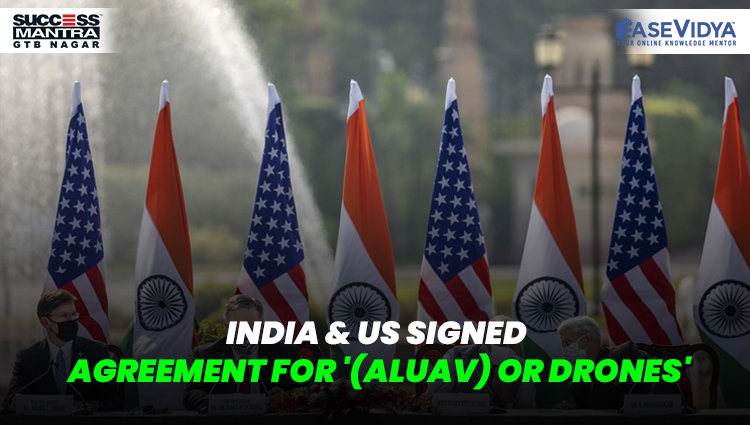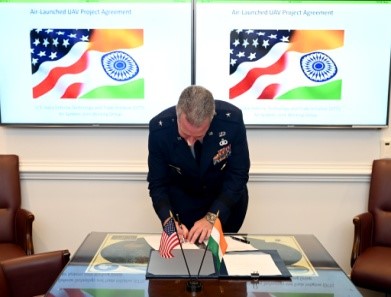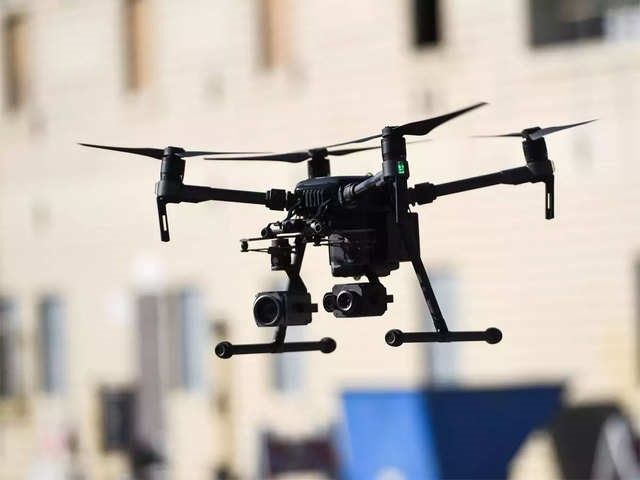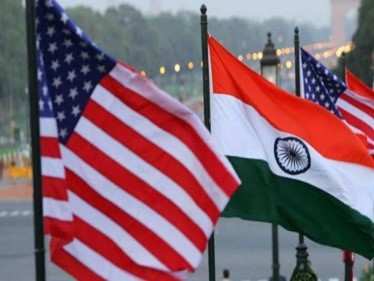
INDIA AND US SIGNED AGREEMENT FOR ALUAV OR DRONES
INDIA & US SIGNED AGREEMENT FOR '(ALUAV) OR DRONES'

Ministry of Defence, Government of India, and the US Department of Defence signed a Project Agreement (PA) for Air-Launched Unmanned Aerial Vehicle (ALUAV) under the Joint Working Group Air Systems in the Defence Technology and Trade Initiative (DTTI). The agreement is a significant step that aims at deepening Defence technology collaborations between both nations through the co-development of Defence equipment. The Project Agreement (PA) for Air-Launched Unmanned Aerial Vehicle (ALUAV) comes under the Research, Development, Testing, and Evaluation (RDT&E) Memorandum of Agreement between the Ministry of Defence and the US Department of Defence. The Memorandum was signed first in January 2006 and renewed in January 2015.
ABOUT THE PROJECT AGREEMENT (PA)

- Aim: It aims towards design, development, demonstration, testing and evaluation of systems to co-develop an ALUAV prototype. The PA for the ALUAV fell under the Research, Development, Testing and Evaluation Memorandum of Agreement between MoD and US DoD. It was first signed in January 2006 and renewed in January 2015.
- Indian Participants: The PA outlines the collaboration between Air Force Research Laboratory, Indian Air Force, and Defence Research and Development Organisation (DRDO).
- Execution: The Aeronautical Development Establishment at the DRDO and the Aerospace Systems Directorate at the Air Force Research Laboratory, along with the Indian and US Air Forces are the principal organisations for the execution of the PA.
- Significance: It was a significant step towards deepening defence technology collaboration between the two nations through co-development of defence equipment. It could in the future lead to joint manufacture of artificial intelligence-enabled drone swarms capable of being launched from aircraft to overwhelm an adversary’s air defence systems.
DEFENCE TRADE AND TECHNOLOGY INITIATIVE (DTTI)
Formation: The DTTI was announced in 2012 as an ambitious initiative for co-production and co-development of military systems but has never really taken off despite several efforts.
Aim:To strengthen the US and India’s defence industrial base by moving away from the traditional “buyer-seller” dynamic toward a more collaborative approach. This would be through exploring new areas of technological collaboration through co-development and co-production.
Projects: The projects under DTTI have been identified as the near, medium and long term projects. The near-term projects included so far are Air-launched Small Unmanned Systems (drone swarms), LightWeight Small Arms Technology and Intelligence-Surveillance-Targeting & Reconnaissance (ISTAR) systems. The medium-term projects identified are Maritime Domain Awareness Solution and Virtual Augmented Mixed Reality for Aircraft Maintenance or VAMRAM. The two long term projects are Terrain Shaping Obstacle (lethal munitions) and anti-drone technology called Counter-UAS, Rocket, Artillery & Mortar (CURAM) system for the Indian Army.
Joint Working Group: Under the DTTI, Joint Working Groups on land, naval, air, and aircraft carrier technologies have been established for focus on mutually agreed projects in respective domains.
OTHER MAJOR AGREEMENTS BETWEEN INDIA AND US

BECA Agreement: The Basic Exchange and Cooperation Agreement largely pertains to geospatial intelligence, and sharing information on maps and satellite images for defence. BECA will provide Indian military systems with a high-quality GPS to navigate and missiles with real-time intelligence to precisely target the adversary. It will give access to topographical and aeronautical data and products that will aid navigation and targeting.
Significance of Signing of BECA
Converging Indo-Pacific Strategies: Signing of BECA will fast-forward the integration of the Indo-Pacific strategies of their two countries. Further, this is in sync with increasing formalization of QUAD, which can be seen in the recent joining of Australia in the Malabar naval exercises. India will be able to keep a close watch on the movements of Chinese warships in the Indian Ocean. Moreover, its signing comes at a time when India is locked in one of its most hostile standoffs with China along their disputed border in the Himalayan region.
Deep Military Implications: While LEMOA means one partner trusts the other enough to expose its valuable assets, COMCASA means one is confident that it can rely on encrypted systems to connect the two militaries, and BECA means it can share highly classified information in real time without fear of being compromised.
General Security of Military Information Agreement GSOMIA allows militaries to share the intelligence gathered by them. Signed by India in 2002. An extension to the GSOMIA, the Industrial Security Annex (ISA), was signed at the 2+2 dialogue in 2019. ISA provides a framework for exchange and protection of classified military information between the USA and Indian defence industries.
Logistics Exchange Memorandum of Agreement LEMOA allows both countries to have access to each other’s designated military facilities for refueling and replenishment. Signed by India in 2016.
Communications and Information Security Memorandum of Agreement COMCASA (Communications Compatibility and Security Agreement) is the India specific version of CISMOA. Valid for 10 years, COMCASA aims to provide a legal framework for the transfer of highly sensitive communication security equipment from the USA to India that will streamline and facilitate interoperability between their armed forces. Signed by India in 2018. The Communication Compatibility and Security Agreement (COMCASA) was signed in 2018. It aims to facilitate communication between the weapons platforms of the two armed forces.
TEST YOURSELF
Q.1 Recently, which of the following countries have signed a Project Agreement (PA) to jointly develop an Air-launched Unmanned Aerial Vehicle (ALUAV) or drones that can be launched from an aircraft?
- India & United States of America: ANSWER
- United States of America & Russia
- India & Russian Federation
- None of the above
Q.2 The Defence Trade and Technology Initiative (DTTI), an ambitious initiative to strengthen the US and India’s defence industrial base was announced in ________?
- 2008
- 2010
- 2012: ANSWER
- 2019
Q.3 India-US signed BECA agreement for Geo-Spatial Cooperation stands for?
- Bilateral Exchange and Cooperation Agreement
- Basic Enhanced Cooperation Agreement
- Basic Exchange and Cooperation Agreement: ANSWER
- None of the above
Q.4 Consider the given options & state which of the following is the foundational defence agreement between India & USA?
- The Basic Exchange and Cooperation Agreement (BECA)
- Communication Compatibility and Security Agreement (COMCASA)
- Logistics Exchange Memorandum of Agreement (LEMOA)
- General Security of Military Information Agreement (GSOMIA)
- I & IV follows
- I, II & IV follows
- I, II & III follows
- All of the above: ANSWER
Q.5 Consider the given statements & state which of the following is/are incorrect in the reference to the Indo-US bilateral relationship?
- Both are united in confronting Covid-19 together & in dealing with the challenge posed by climate change.
- The bilateral Strategic Energy Partnership was launched in April 2020 under which India has started importing crude and LNG from the US: ANSWER
- A foundational military agreement was signed that allows for the sharing of encrypted communications and equipment (COMCASA- Communications Compatibility and Security Agreement).
- None of the following












0 Comment